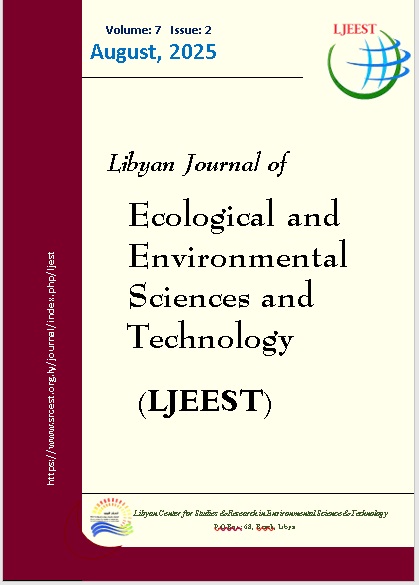Microalgae as Indicators to Assess Trophic Status and Organic Pollution in the Seven Brackish Lakes, North of Benghazi, Libya
DOI:
https://doi.org/10.63359/3j696022Keywords:
Palmer index, Nygaard index, Diatom's index, BioindicatorsAbstract
This study investigates the use of microalgae as bioindicators to assess the trophic status and organic pollution levels in the Seven Brackish Lakes located north of Benghazi, Libya. Microalgae, due to their rapid response to environmental changes and their central role in aquatic ecosystems, serve as effective indicators of water quality. Over four seasons sampling period, qualitative and quantitative analyses of microalgae communities were conducted across 6 sites within the lakes. Key ecological indices, including Nygaard index, Palmer Pollution Index and trophic diatoms index were employed to evaluate trophic status and pollution levels. During the four seasons from October 2022 to July 2023, 33 species following to 27 genera and 5 divisions were recorded from in the seven lakes north of Benghazi. The most diverse group was Chlorophyta (49%), followed by Cyanobacteria (21%), Bacillariophyta (12%), Euglenophyta (9%) and Dinophyta (9%) as well. Results revealed significant organic pollution conditions based on palmer index (score = 36) with higher abundances of eutrophication based on the compound Nygaard index indicated(score =9) and trophic diatoms index ( score = 4 to 4.5). These findings suggest a gradient from mesotrophic to hypereutrophic conditions within the lake system, corresponding to varying degrees of anthropogenic impact, particularly domestic and agricultural runoff.
References
References:
Çelekli A, Lekesiz Ö, Çetin T. (2022). Eco-assessment of least disturbed areas of the Antalya River basin: application of diatom indices from diferent ecoregions. Environ Sci Pollut Res 29:790– 804. https://doi.org/10.1007/s11356-021-15394-0
Çelekli A, Lekesiz Ö, Yavuzatmaca M. (2021). Bioassessment of water quality of surface waters using diatom metrics. Turk J Botany 45:379–396. https://doi.org/10.3906/bot-2101-16
Costa APT, Schneck F. (2022). Diatoms as indicators in running waters: trends of studies on biological assessment and monitoring. Environ Monit Assess 194:695. https://doi.org/10.1007/ s10661-022-10383-3
Delgado C, Pardo I. (2015). Comparison of benthic diatoms from Mediterranean and Atlantic Spanish streams: community changes in relation to environmental factors. Aquat Bot 120:304–314. https:// doi.org/10.1016/j.aquabot.2014.09.010
Gökçe, D. (2016). Algae as an indicator of water quality. Algae-Organisms for Imminent Biotechnology, 81-101.
Hamaidi-Chergui, F., Errahmani, M. B., Hamaidi, M. S., Benouaklil, F., & Kais, H. (2014). Preliminary survey of phytoplankton Lakhal Lake Dam (Southeast 0f Algeria) By using Palmer and Nygaard’s Algal index. Lakes, Reservoirs and Ponds, 8(2), 122-
Hasan, M. M., Gani, M. A., Alfasane, M. A., Ayesha, M., & Nahar, K. (2023). Benthic diatom communities and a comparative seasonal-based ecological quality assessment of a transboundary river in Bangladesh. Plos one, 18(10), e0291751. | https://doi.org/10.1371/journal.pone.0291751
Lekesiz, Ö., Çelekli, A., Yavuzatmaca, M., & Dügel, M. (2024). Determination of ecological statuses of streams in the Ceyhan River Basin using composition and ecological characteristics of diatoms. Environmental Science and Pollution Research, 31(23), 34738-34755.
Lobo, EA, Schuch, M, Heinrich, CG. (2015). Development of the Trophic Water Quality Index (TWQI) for subtropical temperate Brazilian lotic systems. Environ Monit Assess 187:354. https:// doi.org/10.1007/s10661-015-4586-3
Mamun, M., Atique, U., & An, K. G. (2021). Assessment of water quality based on trophic status and nutrients-chlorophyll empirical models of different elevation reservoirs. Water, 13(24), 3640.
Mishra, V., Sharma, S.K., Sharma, B.K., Sharma, L.L. and Shukla, A., (2017). Seasonal Phytoplankton Diversity using Palmer’s Pollution Index of Pichhola Lake Dist.- Udaipur (Rajasthan) India, Int. J. Pure App. Biosci. 5(4): 1857-1861. doi: http://dx.doi.org/10.18782/2320-7051.5406
Palmer, C. M. (1969). A composite rating of algae tolerating organic pollution 2. Journal of phycology, 5(1), 78-82.
Stevenson, J. (2014). Ecological assessments with algae: a review and synthesis. Journal of Phycology, 50(3), 437-461.
Tolboom, S. N., Carrillo-Nieves, D., de Jesús Rostro-Alanis, M., de la Cruz Quiroz, R., Barceló, D., Iqbal, H. M., & Parra-Saldivar, R. (2019). Algal-based removal strategies for hazardous contaminants from the environment–a review. Science of the Total Environment, 665, 358-366.
Viso R, Blanco S. (2023). River diatoms reflect better past than current environmental conditions. Water (Switzerland) 15. https://doi. org/10.3390/w15020333
Downloads
Published
Issue
Section
License
Copyright (c) 2025 Libyan Journal of Ecological & Environmental Sciences and Technology

This work is licensed under a Creative Commons Attribution-NonCommercial 4.0 International License.















